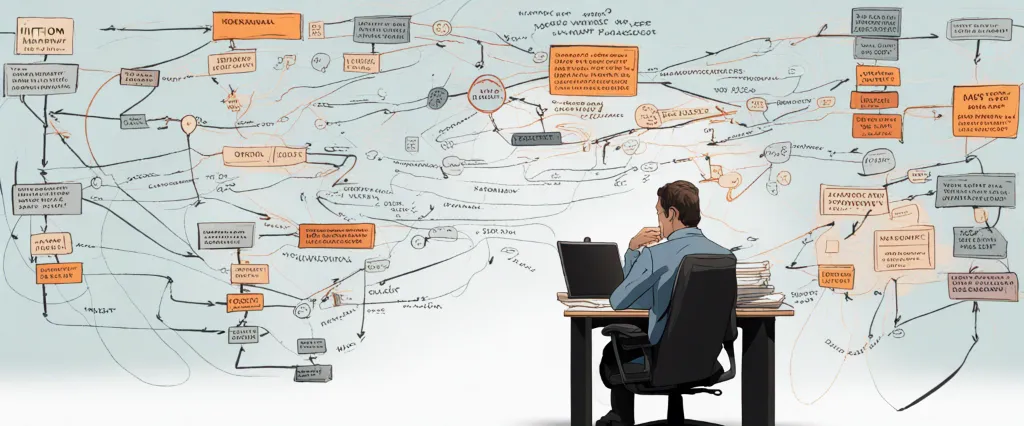In The Manager’s Path by Camille Fournier, author Camille Fournier delves into the essential skills required to transition from an individual contributor to an effective manager in the fast-paced world of technology. Drawing from her extensive experience as a software engineer, technology executive, and author, Fournier navigates readers through the various stages of management, providing practical insights, tips, and strategies for success. This comprehensive guidebook is an indispensable resource for tech professionals aspiring to lead and excel in their managerial roles.
Chapter 1:Understanding the journey to becoming an effective manager
Chapter 1 of “The Manager’s Path” by Camille Fournier provides an insightful overview of the journey to becoming an effective manager. The author emphasizes that management is a role that requires constant learning and adaptation. Fournier starts by debunking the common misconception that management is a promotion from being an individual contributor. Instead, she explains that it is a career change that necessitates different skill sets and mindsets.
The chapter highlights the three distinct phases of becoming an effective manager: the learning phase, the growing phase, and the mentoring phase. During the learning phase, new managers must familiarize themselves with the responsibilities and challenges of managing a team. They must develop time management skills, learn to delegate, and grasp the importance of clear communication. This phase also requires self-reflection and introspection to understand one’s strengths and weaknesses as a manager.
In the growing phase, managers begin to cultivate their individual management styles. They focus on building trust with their team, developing and executing a team vision, and prioritizing feedback and recognition. This phase also involves learning from mistakes and leveraging experiences to continually improve as a manager.
The final phase, the mentoring phase, centers around fostering growth in others. Managers in this phase shift their focus from managing tasks to developing their team members’ skills, providing mentorship, and preparing them for future leadership roles. They also embrace the role of an advocate, advocating for their team’s needs and supporting career progression opportunities.
Throughout the chapter, Fournier emphasizes that becoming an effective manager is not a linear journey but rather a continuous process of growth and adaptation. The key is to constantly learn, seek feedback, and adjust one’s approach to lead effectively.
Chapter 2: Developing technical expertise and leadership skills
Chapter 2 of “The Manager’s Path” by Camille Fournier focuses on the importance of developing technical expertise and leadership skills for managers. Fournier highlights the significance of a manager’s ability to earn the respect of their team by demonstrating technical proficiency and effectively leading their members.
The chapter begins by emphasizing the need for managers to maintain their technical expertise even as they transition into leadership roles. Fournier explains that having a solid technical background not only enables managers to understand and solve complex problems but also helps them gain credibility among their team members. By staying up-to-date with industry trends and maintaining a passion for learning, managers can foster an environment of growth and inspire their team to do the same.
Fournier also explores the importance of honing leadership skills. The author emphasizes that being a manager requires more than just being technically competent – effective leadership is crucial for creating a cohesive and motivated team. Fournier provides practical advice on how managers can develop their leadership skills, such as seeking feedback, mentoring others, and being open to learning from their team.
Throughout the chapter, Fournier emphasizes the need for managers to strike a balance between technical expertise and leadership skills. By continuously developing both areas, managers can create a high-performing team that respects their technical abilities and trusts their leadership.
In conclusion, Chapter 2 of “The Manager’s Path” highlights the importance of developing technical expertise and leadership skills for managers. It emphasizes the need for managers to maintain their technical proficiency while also honing their leadership abilities to effectively lead and inspire their team.
Chapter 3:Navigating different management roles and responsibilities
Chapter 3 of “The Manager’s Path” by Camille Fournier delves into the various management roles and responsibilities that individuals encounter throughout their career progression. Fournier emphasizes the significance of understanding these different roles to enable effective management at each level.
The chapter begins by discussing the entry-level role of an individual contributor, where the primary focus is on technical skills and fulfilling tasks efficiently. As one progresses to the first level of management, the role shifts to that of a mentor and coach, guiding and aiding the growth of less experienced individuals. Fournier advises managers to overcome the inclination to execute tasks themselves by delegating responsibilities, allowing team members to develop their skills.
Moving onto middle management, the author highlights the key responsibilities of strategic thinking and alignment. Middle managers must balance individual team goals with the overall organizational objectives, aligning the efforts of different teams and departments. Fournier advises managers in this role to pay attention to cross-functional work and develop strong relationships with other managers.
Lastly, Fournier explores the executive management level, where the focus shifts to setting the broader vision and strategy of an organization. She emphasizes the importance of cultivating leadership skills, such as decision-making, communication, and empathy, to effectively manage at this level. Executives must also prioritize fostering collaboration, hiring the right talent, and creating a positive organizational culture.
Throughout the chapter, Fournier emphasizes that each level of management comes with its unique set of challenges, and individuals must adapt and learn continuously as they progress. By understanding and embracing the responsibilities of different management roles, professionals can successfully navigate their managerial journey and contribute to their organization’s success.
Chapter 4:Building and leading high-performing teams

Chapter 4: “Building and Leading High-Performing Teams” of the book “The Manager’s Path” by Camille Fournier discusses the importance of creating and nurturing highly effective teams as a manager. Fournier emphasizes that a manager’s success depends on the collective success of their team and provides valuable insights on how to achieve this.
The chapter begins by highlighting the significance of hiring the right people. Fournier emphasizes the need to focus on both technical skills and cultural fit to build a cohesive team. She suggests involving the team members in the hiring process and establishing a clear set of criteria to evaluate candidates.
Once the team is formed, Fournier emphasizes the importance of setting clear expectations and goals. Communicating these expectations effectively helps team members understand their roles and responsibilities, which fosters a sense of ownership and accountability. Regular feedback and coaching are encouraged to ensure continuous improvement.
To cultivate high-performance, Fournier emphasizes the need for psychological safety within the team. This entails creating an environment where team members feel comfortable taking risks, sharing ideas, and challenging the status quo. Encouraging open and honest communication builds trust and fosters a culture of collaboration.
The chapter also addresses the issue of conflict within teams. Fournier stresses the importance of addressing conflicts early on and providing a safe space for team members to resolve issues. Effective conflict resolution strategies, such as active listening and encouraging empathy, are discussed.
Fournier concludes the chapter by emphasizing the importance of diversity and inclusion in high-performing teams. She highlights the benefits of diverse perspectives and experiences, and provides advice on how to create an inclusive environment that values all team members’ contributions.
In summary, Chapter 4 of “The Manager’s Path” emphasizes the significance of building and leading high-performing teams. It provides valuable guidance on hiring the right people, setting clear expectations, fostering psychological safety, managing conflicts, and promoting diversity and inclusion. By implementing the strategies outlined in this chapter, managers can drive their teams towards success and achieve their goals.
Chapter 5:Managing conflicts and fostering a positive work environment
Chapter 5 of “The Manager’s Path” by Camille Fournier delves into the crucial topic of managing conflicts and cultivating a positive work environment. Fournier emphasizes that conflict is a natural occurrence in any workplace and that understanding how to handle it effectively is essential for a manager.
The chapter starts by highlighting the importance of addressing conflicts promptly. Fournier advises managers to intervene early, before the situation escalates into something more significant. She emphasizes the significance of active listening and having open, honest communication with all parties involved. A manager should listen to understand the underlying issues and help facilitate a productive dialogue to resolve the conflict.
Fournier also introduces the concept of positional vs. interest-based conflict resolution. While positional resolution focuses on individuals holding their ground and trying to win, interest-based resolution encourages parties to explore their underlying needs and find solutions that best meet those needs. The author advocates for interest-based resolution as it often leads to more satisfactory outcomes and strengthens working relationships.
Another important aspect of managing conflicts is understanding power dynamics. Fournier advises managers to be mindful of any potential power imbalances and be prepared to use their authority to address conflicts and create a fair and just resolution.
Creating a positive work environment is also addressed in this chapter. Fournier emphasizes the significant impact of a manager’s behavior on the overall atmosphere of the team. She suggests fostering a culture of trust and respect, where diverse perspectives are welcomed and collaboration is encouraged. Effective managers should actively engage in conflict prevention by addressing any signs of negativity, providing feedback, and encouraging open dialogue.
In summary, Chapter 5 of “The Manager’s Path” emphasizes the importance of managing conflicts promptly and effectively, utilizing interest-based conflict resolution, being mindful of power dynamics, and cultivating a positive work environment through trust, respect, and open communication.
Chapter 6:Balancing short-term goals with long-term career growth
Chapter 6: Balancing Short-Term Goals with Long-Term Career Growth of the book “The Manager’s Path” by Camille Fournier discusses the importance of finding a balance between short-term goals and long-term career growth as a manager.
Fournier starts by highlighting the natural inclination of managers to focus on short-term goals and immediate results, which can often hinder long-term career growth. While it is crucial to deliver on current objectives and meet deadlines, it is equally important to invest in personal and professional growth, which will propel a manager’s career in the long run.
The author emphasizes the significance of dedicating time to activities that contribute to long-term career development. This includes building relationships, learning new skills, and seeking opportunities for growth and advancement. Fournier explains that these investments might not provide immediate benefits but will pay off in the future by opening doors to new and challenging roles.
To achieve this balance, the author suggests organizing time by categorizing activities into short-term, medium-term, and long-term goals. By allocating specific periods or blocks for each type of activity, managers can ensure they are not solely focusing on immediate needs while neglecting their long-term growth.
It is also essential for managers to communicate their desire for career growth with their superiors and actively seek out opportunities within their organization. This demonstrates ambition and a readiness to take on new challenges, increasing the chances of progression.
Lastly, Fournier emphasizes that striking a balance between short-term goals and long-term career growth requires discipline and self-awareness. Managers must resist the temptation to prioritize short-term wins at the expense of their long-term aspirations.
Overall, Chapter 6 of “The Manager’s Path” highlights the necessity of balancing immediate goals with long-term career growth. It provides practical advice on allocating time, seeking growth opportunities, and fostering self-awareness to ensure managers advance in their careers while effectively meeting short-term objectives.
Chapter 7:Embracing continuous learning and professional development
Chapter 7 of “The Manager’s Path” by Camille Fournier focuses on the importance of continuous learning and professional development for managers. Fournier emphasizes that successful managers must be lifelong learners and continuously evolve their skills and knowledge to effectively lead their teams.
The chapter begins by discussing the necessity of learning new technologies and tools relevant to the manager’s field. Fournier argues that managers should always strive to stay up-to-date with emerging trends and technologies to better support their teams and make informed decisions. They should invest time in research, attend conferences, and seek out mentors to improve their technical expertise.
Fournier then explores the significance of acquiring non-technical skills, such as leadership and communication. She emphasizes that managers should actively develop these skills to effectively manage individuals and teams. Effective communication, for instance, helps managers build trust, provide feedback, and motivate their team members. The chapter also highlights the importance of learning to manage conflict and navigate organizational politics.
Furthermore, Fournier encourages managers to embrace opportunities for skill development and professional growth. This involves seeking challenges and taking on projects that stretch one’s capabilities. It also entails actively seeking feedback from peers and team members to identify areas of improvement.
In conclusion, Chapter 7 of “The Manager’s Path” emphasizes the importance of continuous learning and professional development for managers. Fournier stresses the need for managers to stay updated with technical trends, enhance their non-technical skills, and actively seek growth opportunities. By embracing continuous learning, managers can adapt to new challenges and effectively lead their teams to success.

Chapter 8: Cultivating a leadership style that inspires and motivates others
Chapter 8 of “The Manager’s Path” by Camille Fournier, titled “Cultivating a leadership style that inspires and motivates others,” delves into the various aspects of becoming an effective leader who can inspire and motivate their team members. Fournier emphasizes the importance of understanding oneself as a leader and tailoring one’s management style to fit the needs and preferences of individual team members.
The chapter starts by highlighting the significance of self-awareness and self-reflection. Fournier argues that as a leader, it is crucial to understand one’s own strengths, weaknesses, and triggers to cultivate an authentic leadership style. She advises managers to actively seek feedback from both superiors and subordinates, as it provides valuable insights into areas for improvement or personal blind spots.
Furthermore, the author emphasizes the need for leaders to develop and foster strong relationships with their team members. This involves having one-on-one meetings, providing regular feedback, and truly listening to their concerns and aspirations. By understanding each team member’s goals and aspirations, managers can tailor their leadership approach to motivate and inspire individuals.
Fournier also discusses the significance of modeling the desired behaviors and values as a leader. By embodying the qualities they expect from their team, managers can inspire others to follow suit. Additionally, she highlights the importance of setting clear expectations and providing guidance, as well as celebrating team successes and acknowledging individual achievements.
The chapter concludes by emphasizing the continuous learning and growth necessary for effective leadership. Fournier encourages managers to seek out mentorship, participate in leadership development programs, and read books and articles on the subject to further enhance their leadership skills.
In summary, Chapter 8 focuses on the development of a leadership style that inspires and motivates others. Fournier emphasizes the importance of self-awareness, building strong relationships, modeling desired behaviors, setting clear expectations, and continuous learning and growth. By cultivating these aspects of leadership, managers can create an environment that fosters motivation, engagement, and high performance among their team members.
After Reading
In conclusion, “The Manager’s Path” by Camille Fournier provides a comprehensive guide for anyone transitioning into a management role in the tech industry. Fournier’s extensive experience as a software engineer and CTO allows her to offer practical advice on different managerial levels and situations. The book covers various topics such as team building, leadership styles, communication, and career development. Fournier emphasizes the importance of understanding individual team members and their unique needs, as well as fostering a supportive and inclusive work environment. Overall, “The Manager’s Path” serves as an invaluable resource for both aspiring and experienced tech managers, providing valuable insights and strategies for success in the challenging world of management.
1. High Output Management” by Andrew S. Grove – This classic management book provides practical guidance for executives and managers, covering topics such as team dynamics, goal setting, and decision-making processes. It helps readers cultivate effective leadership skills and improve their ability to manage teams.
2. “Radical Candor: Be a Kick-Ass Boss Without Losing Your Humanity” by Kim Scott – In this book, Scott shares her experiences as a manager at Google and offers a framework for leading with empathy and honesty. It emphasizes the importance of building strong relationships, giving feedback, and fostering a culture of open communication.
3. The Effective Executive: The Definitive Guide to Getting the Right Things Done” by Peter F. Drucker is a timeless resource for enhancing personal effectiveness. It emphasizes the importance of setting priorities, making informed decisions, and managing time efficiently, empowering executives to achieve their goals and maximize their impact.
4. Measure What Matters: How Google, Bono, and the Gates Foundation Rock the World with OKRs” by John Doerr – As a renowned venture capitalist, Doerr highlights the value of setting and tracking Objectives and Key Results (OKRs) to drive organizational success. This book provides practical insights and case studies, demonstrating how goal-setting frameworks can transform businesses.
5. High Output Management” by Andrew S. Grove is a classic management guide that offers practical insights on optimizing productivity and organizational performance. It provides valuable strategies for effective decision-making, team building, and operational excellence, making it a must-read for managers and leaders.
These five books provide a range of perspectives on effective management and leadership, examining various aspects of team-building, goal-setting, and organizational culture. Whether you are a seasoned manager or aspiring to lead a team, these recommendations offer valuable insights and practical strategies for success.




